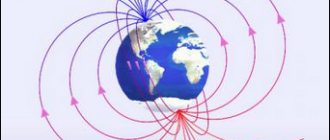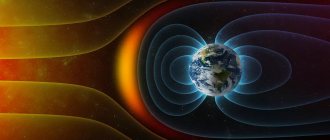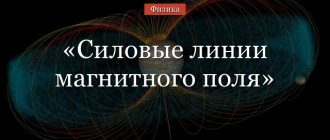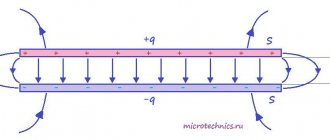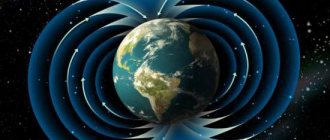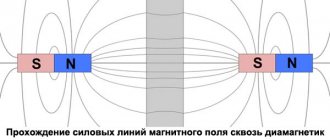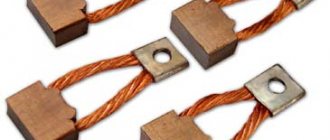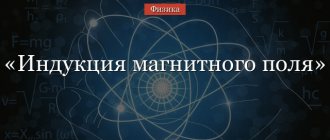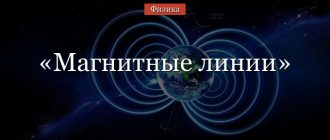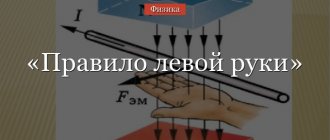A magnetic field
Already in the 6th century. BC. In China, it was known that some ores have the ability to attract each other and attract iron objects. Pieces of such ores were found near the city of Magnesia in Asia Minor, so they were called magnets
.
How do magnets and iron objects interact? Let's remember why electrified bodies are attracted? Because a peculiar form of matter is formed near an electric charge - an electric field. There is a similar form of matter around the magnet, but it has a different nature of origin (after all, the ore is electrically neutral), it is called a magnetic field
.
To study the magnetic field, straight or horseshoe magnets are used. Certain places of a magnet have the greatest attractive effect; they are called poles
(north and south)
. Opposite magnetic poles attract, and like magnetic poles repel.
For the strength characteristics of the magnetic field, use the magnetic field induction vector B
.
The magnetic field is graphically represented using lines of force ( magnetic induction lines
). Lines are closed, have neither beginning nor end. The place from which magnetic lines emerge is the North Pole; magnetic lines enter the South Pole.
The magnetic field can be made “visible” using iron filings.
Magnetic lines of a strip magnet
With a simple experiment you can demonstrate the properties of magnetic lines. A strip magnet is placed on a horizontal surface, with a transparent (non-metallic) plate on top of it, onto which fine iron filings are sprinkled. Under the influence of a magnet, the sawdust becomes magnetized and becomes like magnetic arrows. It can be seen that the sawdust is located along the magnetic lines that leave the north pole N and enter the south pole S. The lines are most densely located in the area of the magnet poles.
Rice. 1. Magnetic lines of a strip magnet
Magnetic field of a current-carrying conductor
And now about what Hans Christian Oersted
and
André Marie Ampère
in 1820. It turns out that a magnetic field exists not only around a magnet, but also around any current-carrying conductor. Any wire, such as a lamp cord, through which electric current flows is a magnet! A wire with current interacts with a magnet (try holding a compass near it), two wires with current interact with each other.
Direct current magnetic field lines are circles around a conductor.
Magnetic induction vector direction
The direction of the magnetic field at a given point can be defined as the direction indicated by the north pole of a compass needle placed at that point.
The direction of the magnetic induction lines depends on the direction of the current in the conductor.
The direction of the induction vector is determined using the gimlet
or
right hand
.
Ampere power
To determine the direction of the Ampere force, the left-hand rule
: if the palm of the left hand is positioned so that the perpendicular component to the conductor of the induction vector (\(~\vec B\)) enters the palm, and four extended fingers indicate the direction of the current (
I
), then the thumb bent 90° will indicate the direction Ampere forces (\(~\vec F_A\)) (Fig. 6).
Rice. 6
\(~F_A = I \cdot B \cdot l \cdot \sin \alpha\) ,
where F
A – Ampere force (N);
B
– module of the magnetic induction vector (T);
I
– current strength (A);
l
– conductor length (m);
α
is the angle between the conductor (the direction of the current in the conductor) and the direction of the magnetic induction vector.
Torque force
\(~B = \frac{M_{max}}{I \cdot S}\) ,
where B
– module of the magnetic induction vector (T);
M
max – maximum torque acting on a current-carrying frame located in a magnetic field (Nm);
I
– current strength in the frame (A);
S
– frame area (m2).
Let us place in a uniform magnetic field with induction (\(~\vec B\)) a rectangular frame with current ABCD
(Fig. 7 a - side view; Fig. 7 b - top view), where
AB
=
a
,
AD
=
b
,
β
is the angle between the perpendicular to the frame and the magnetic induction vector.
A
b
Rice. 7
To AD
and
BC
magnetic field act with forces that vary from zero to a maximum value (depending on the angle of rotation of the frame
β
) and tend to stretch the frame (these forces are not indicated in Fig. 8a).
on sections AB
and
CD
with constant forces \(~\vec F_1\) and \(~\vec F_2\), which are directed in opposite directions (in Fig. 7a the forces are directed perpendicular to the plane of the picture) and tend to rotate the frame around the
OO´
.
Thus, these forces \(~\vec F_1\) and \(~\vec F_2\) create a torque M
=
F
1 ·
l
1 +
F
2 ·
l
2, where
F
1 =
F
2 =
I
·
B
·
l
(angle
α
= 90°),
l
1 =
l
2 =
AD
/2 ·sin
β
=
b
/2 ·sin
β
,
l
=
AB
=
CD
=
a
.
Then \(~M = 2 F_1 \cdot l_1 = 2 I \cdot B \cdot a \cdot \frac{b}{2} \cdot \sin \beta = I \cdot B \cdot a \cdot b \cdot \ sin \beta = I \cdot B \cdot S \cdot \sin \beta\) ,
where S
=
a
·
b
– frame area.
The moment of forces will be maximum at β
= 90° (the frame is located along the induction lines)
\(~M_{max} = I \cdot B \cdot S\) .
Note
. This formula is true for a flat frame of any shape.
Magnetic induction vector
This is a vector quantity characterizing the force action of the field.
Induction of the magnetic field of an infinite straight conductor with current at a distance r from it:
Magnetic field induction at the center of a thin circular coil of radius r:
Solenoid magnetic field induction
(a coil whose turns are sequentially passed current in one direction):
Lorentz force
To determine the direction of the Lorentz force, the left-hand rule
: if the left hand is positioned so that the perpendicular component to the particle velocity (\(~\vec \upsilon\)) of magnetic induction (\(~\vec B\)) enters the palm, and four extended fingers indicate the direction of movement of the
positively charged particles
, then the thumb bent by 90° will indicate the direction of the Lorentz force (\(~\vec F_L\)) acting from the magnetic field on the particle (Fig. 8 a).
For a negative particle,
four extended fingers are directed against the movement of the particle (Fig. 8 b).
- A
- b
Rice.
8 \(~F_L = q \cdot B \cdot \upsilon \cdot \sin \alpha\) , where F
L – Lorentz force (N);
q
– charge modulus of a moving particle (C);
υ
– particle speed (m/s);
B
– module of the magnetic induction vector (T);
α
is the angle between the speed of movement of the positive charge and the magnetic induction vector.
Earth's magnetic field
The Earth is not only a large negative charge and a source of electric field, but at the same time the magnetic field of our planet is similar to the field of a direct magnet of gigantic proportions.
Geographic south is close to magnetic north, and geographic north is close to magnetic south. If a compass is placed in the Earth's magnetic field, then its north arrow is oriented along the lines of magnetic induction in the direction of the south magnetic pole, that is, it will show us where the geographic north is located.
The characteristic elements of the earth's magnetism change very slowly over time - secular changes
. However, from time to time magnetic storms occur, when the Earth's magnetic field is greatly distorted for several hours and then gradually returns to its previous values. Such a drastic change affects people's well-being.
The Earth's magnetic field is a “shield” that protects our planet from particles penetrating from space (“solar wind”). Near the magnetic poles, particle flows come much closer to the Earth's surface. During powerful solar flares, the magnetosphere is deformed, and these particles can move into the upper layers of the atmosphere, where they collide with gas molecules, forming auroras.
Determination of magnetic field
When studying electrical phenomena in 8th grade, you learned that in the space around a charged body there is a field called electric, and that it is through this field that electrical interaction between charged bodies and particles occurs.
There is also a field near a magnetized body and near a conductor carrying current - it is called magnetic. Magnetic interaction occurs at a certain speed through a magnetic field (the first to come to this conclusion was the English physicist Michael Faraday (1791-1867)).
Rice. 1.3. Coils carrying current behave like permanent magnets
Let's consider the interaction of a permanent magnet and a coil with current (Fig. 1.3, b). A coil carrying current creates a magnetic field. The magnetic field spreads in space and begins to act on a permanent magnet (magnetized body) - the magnet is deflected. The magnet also creates its own magnetic field, which, in turn, acts on the current-carrying coil, and the coil also deflects.
Note that a magnetic field also exists near any moving charged particle and near any moving charged body and acts with some force on charged bodies and particles moving in this magnetic field.
Please note: we cannot see the magnetic field, but at the same time it, like the electric field, is absolutely real - it is a form of matter.
A magnetic field is a form of matter that exists near magnetized bodies, current-carrying conductors, moving charged bodies and particles and acts on other magnetized bodies, current-carrying conductors, moving charged bodies and particles located in this field.
Let's summarize:
Bodies that retain their magnetic properties for a long time are called permanent magnets. The main properties of permanent magnets: 1) the magnetic effect of a magnet is most pronounced near its poles; 2) like poles of magnets repel, unlike poles attract; it is impossible to obtain a magnet with only one pole; 3) when a permanent magnet is heated to a certain temperature (Curie point), its magnetic properties disappear.
Magnetic interaction is carried out through a magnetic field. A magnetic field is a form of matter that exists near magnetized bodies, current-carrying conductors, moving charged bodies and particles and acts on magnetized bodies, current-carrying conductors, moving charged bodies and particles located in this field.
Magnetic field induction, magnetic induction lines
We cannot see the magnetic field, but to better understand magnetic phenomena it is important to learn how to depict it. Magnetic needles will help with this. Each such arrow is a small permanent magnet that easily rotates in a horizontal plane (Fig. 2.1). You will learn from this paragraph how the magnetic field is graphically depicted and what physical quantity characterizes it.
Rice. 2.1. A magnetic needle is a permanent magnet. The dotted line shows the axis of the magnetic needle
Magnetic field strength characteristic
If a charged particle moves in a magnetic field, then the field will act on the particle with some force. The magnitude of this force depends on the charge of the particle, the direction and speed of its movement, and also on how strong the field is.
The strength characteristic of a magnetic field is magnetic induction.
Magnetic induction (magnetic field induction) is a vector physical quantity that characterizes the force action of a magnetic field.
Magnetic induction is indicated by the symbol
The SI unit of magnetic induction is tesla ; named after the Serbian physicist Nikola Tesla (1856-1943):
Rice. 2.2. In a magnetic field, magnetic arrows are oriented in a certain way: the north pole of the arrow indicates the direction of the magnetic field induction vector at a given point
The direction of the magnetic induction vector at a given point of the magnetic field is taken to be the direction indicated by the north pole of the magnetic needle installed at this point (Fig. 2.2).
Note! The direction of the force with which the magnetic field acts on moving charged particles or on a current-carrying conductor, or on a magnetic needle, does not coincide with the direction of the magnetic induction vector.
How to express 1 Tesla through other SI units, what formula can be used to determine the magnetic induction module, and the direction of the force with which the magnetic field acts on a current-carrying conductor.
Magnetic lines:
- outside the magnet they leave the north pole of the magnet and enter the south pole;
- always closed (the magnetic field is a vortex field);
- most densely located at the poles of the magnet;
- never intersect
Rice. 2.3. Magnetic field lines of a strip magnet
Magnetic field image
In Fig. 2.2 we see how magnetic needles are oriented in a magnetic field: their axes seem to form lines, and the magnetic induction vector at each point is directed along the tangent to the line passing through this point.
Conditional directed lines, at each point of which the tangent coincides with the line along which the magnetic induction vector is directed, are called magnetic induction lines or magnetic lines .
Magnetic fields are graphically depicted using magnetic lines:
- the direction of the magnetic induction line at a given point is taken to be the direction of the magnetic induction vector;
- The larger the magnetic induction module, the closer the magnetic lines are drawn to each other.
Having examined the graphical representation of the magnetic field of a strip magnet, we can draw some conclusions (see Fig. 2.3). Note that these conclusions are valid for the magnetic lines of any magnet.
The pattern of magnetic lines can be reproduced using iron filings. Let's take a horseshoe magnet, put a plexiglass plate on it and pour iron filings onto the plate through a strainer. In a magnetic field, each piece of iron will be magnetized and turn into a small “magnetic needle”. Improvised “arrows” are oriented along the magnetic lines of the magnet’s magnetic field (Fig. 2.4).
Rice. 2.4. Chains of iron filings reproduce the pattern of magnetic induction lines of the magnetic field of a horseshoe magnet
Rice. 2.5. An area where the magnetic field is uniform
Uniform magnetic field
A magnetic field in a certain part of space is called homogeneous if at each point the magnetic induction vectors are the same both in magnitude and in direction (Fig. 2.5).
Rice. 2.6. The magnetic field inside a strip magnet (a) and between two magnets facing each other with opposite poles (b) can be considered uniform
In areas where the magnetic field is uniform, the magnetic induction lines are parallel and located at the same distance from each other (Fig. 2.5, 2.6). Magnetic lines of a uniform magnetic field directed towards us are usually depicted as dots (Fig. 2.7, a) - it is as if we see “arrowheads” flying towards us. If magnetic lines are directed away from us, then they are depicted with crosses - it’s as if we see the “feathers of arrows” flying away from us (Fig. 2.7, b).
In most cases, we are dealing with a non-uniform magnetic field - a field at different points of which the magnetic induction vectors have different values and directions. The magnetic lines of such a field are curved, and their density is different.
Rice. 2.7. Image of magnetic induction lines of a uniform magnetic field, which are perpendicular to the plane of the drawing and directed towards us (a); directed from us (b)
Earth's magnetic field
To study terrestrial magnetism, William Gilbert made a permanent magnet in the form of a ball (model of the Earth). Having placed a compass on the ball, he noticed that the compass needle behaves in the same way as on the surface of the Earth.
Experiments allowed the scientist to suggest that the Earth is a huge magnet, and its south magnetic pole is located in the north of our planet. Further research confirmed W. Gilbert's hypothesis.
In Fig. Figure 2.8 shows a picture of the magnetic induction lines of the Earth's magnetic field.
Rice. 2.8. Layout of magnetic lines of the magnetic field of planet Earth
The magnetic induction lines of the Earth's magnetic field are not parallel to its surface. If you fix the magnetic needle in a gimbal, that is, so that it can rotate freely around both the horizontal and vertical axes, the needle will be installed at an angle to the surface of the Earth (Fig. 2.9).
Rice. 2.9. Magnetic needle in gimbal
The Earth's magnetic field has long helped travelers, sailors, military personnel and others to navigate. It has been proven that fish, marine mammals and birds orient themselves according to the Earth’s magnetic field during their migrations. Some animals, such as cats, also navigate when looking for the way home.
- Order solutions to physics problems
Magnetic storms
Studies have shown that in any area the Earth's magnetic field changes periodically, every day. In addition, small annual changes in the Earth's magnetic field are observed. However, there are also sudden changes. Strong disturbances in the Earth's magnetic field, which cover the entire planet and last from one to several days, are called magnetic storms. Healthy people practically do not feel them, but for those who have cardiovascular diseases and diseases of the nervous system, magnetic storms cause a deterioration in their well-being.
The Earth's magnetic field is a kind of “shield” that protects our planet from charged particles flying from space, mainly from the Sun (“solar wind”). Near the magnetic poles, streams of particles fly quite close to the Earth's atmosphere. With increasing solar activity, cosmic particles enter the upper layers of the atmosphere and ionize gas molecules - auroras are observed on Earth (Fig. 2.10).
Rice. 2.10. As solar activity increases, the area of dark spots on the Sun increases (a), and magnetic storms and auroras occur on Earth (b)
Let's summarize:
Magnetic induction is a vector physical quantity that characterizes the force action of a magnetic field. The direction of the magnetic induction vector coincides with the direction to which the north pole of the magnetic needle points. The SI unit of magnetic induction is tesla (T).
Conditional directed lines, at each point of which the tangent coincides with the line along which the magnetic induction vector is directed, are called magnetic induction lines or magnetic lines.
Magnetic induction lines are always closed, outside the magnet they leave the north pole of the magnet and enter the south pole, and are denser in those areas of the magnetic field where the magnetic induction module is greater.
Planet Earth has a magnetic field. Near the Earth's north geographic pole is its south magnetic pole, and near its south geographic pole is its north magnetic pole.
Magnetic field of current
You already know that there is a magnetic field near a current-carrying conductor. Let's study the magnetic field of a straight conductor carrying current. To do this, we pass the conductor through a sheet of cardboard (perpendicular to the sheet), sprinkle iron filings on the cardboard and close the circuit. In the magnetic field of the conductor, the sawdust will be magnetized and recreate the picture of the magnetic induction lines of the magnetic field of a straight conductor with current - concentric circles surrounding the conductor (see Fig. 3.1). How to determine the direction of magnetic lines?
